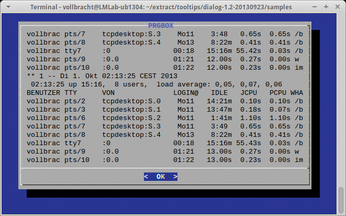Tool tests on the fast track
Tool Tips

Tool review: Dialog 0.7, virtenv 0.8.6, collectd 5.4.0, convmv 1.15, Drukkar 1.11, and ngIRCd 20.3.
Dialog 0.7
Function: User Interfaces to Shell Scripts
Source: http://invisible-island.net/dialog
License: LGPLv2.1
Alternatives: Zenity, Xdialog

Adding graphical dialogs to your own shell scripts is not rocket science. With a tool like Dialog, users can quickly put together an intuitive, straightforward window for user queries. The return values then determine the future course of the script. The C program uses ncurses and thus does not require an X server. Users can control the tool with command-line parameters, thus modifying the appearance and content.
More than 20 different types of dialogs are available, including simple notification boxes, file selection dialogs, and password requests. Since I last took a look at the tool six years ago, the developers have been busy fixing numerous bugs and implementing many new features. For example, the types known from Xdialog buildlist, rangebox, and treeview were added; the makers also adopted the --no-tags and --output-separator options. A new feature, --prgbox, shows output from external programs in the ncurses interface, and --programbox offers an alternative: Pipes let users embed the output from shell commands.
More new features, such as --help-button or --extra-button, allow users to customize the controls in the interface to suit their own needs. The --default-button parameter defines a standard choice for the respective window. An upgrade to the current version of Dialog is definitely worthwhile.
Dialog is ncurses-based, does not require an active X server, and is thus quite frugal. Ideal for use in scripts, such as with SSH for remote maintenance.
[...]
Buy this article as PDF
(incl. VAT)
Buy Linux Magazine
Subscribe to our Linux Newsletters
Find Linux and Open Source Jobs
Subscribe to our ADMIN Newsletters
Support Our Work
Linux Magazine content is made possible with support from readers like you. Please consider contributing when you’ve found an article to be beneficial.

News
-
Mozilla Plans to AI-ify Firefox
With a new CEO in control, Mozilla is doubling down on a strategy of trust, all the while leaning into AI.
-
Gnome Says No to AI-Generated Extensions
If you're a developer wanting to create a new Gnome extension, you'd best set aside that AI code generator, because the extension team will have none of that.
-
Parrot OS Switches to KDE Plasma Desktop
Yet another distro is making the move to the KDE Plasma desktop.
-
TUXEDO Announces Gemini 17
TUXEDO Computers has released the fourth generation of its Gemini laptop with plenty of updates.
-
Two New Distros Adopt Enlightenment
MX Moksha and AV Linux 25 join ranks with Bodhi Linux and embrace the Enlightenment desktop.
-
Solus Linux 4.8 Removes Python 2
Solus Linux 4.8 has been released with the latest Linux kernel, updated desktops, and a key removal.
-
Zorin OS 18 Hits over a Million Downloads
If you doubt Linux isn't gaining popularity, you only have to look at Zorin OS's download numbers.
-
TUXEDO Computers Scraps Snapdragon X1E-Based Laptop
Due to issues with a Snapdragon CPU, TUXEDO Computers has cancelled its plans to release a laptop based on this elite hardware.
-
Debian Unleashes Debian Libre Live
Debian Libre Live keeps your machine free of proprietary software.
-
Valve Announces Pending Release of Steam Machine
Shout it to the heavens: Steam Machine, powered by Linux, is set to arrive in 2026.

